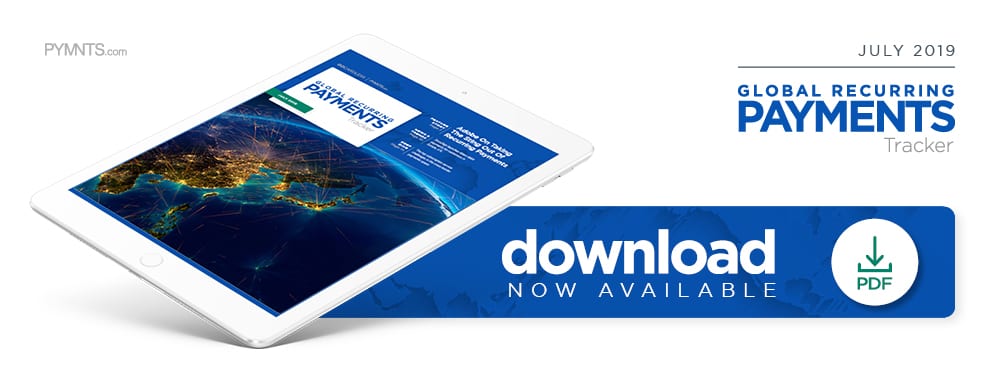Adobe On How Regional Payments Enable Global Growth

For global businesses with recurring billing business models, the costs of FX conversion, transaction processing and failed payments can quickly add up — and not in a good way. To optimize investments and improve customer retention, global businesses need to be more local with their payments practices and strategies, says Adobe Head of Payments Andy Barker. In the Global Recurring Payments Tracker, he tells PYMNTS how Adobe is “taking the sting” out of recurring billing.
Modern consumers purchase everything from software to music streaming to groceries through subscriptions, but even merchants that have been successful in their domestic markets can find it challenging to make the model work abroad. The payment methods that proved popular and effective at home may find little traction when offered overseas, causing customers to defect from or bypass such services entirely.
Making a subscription service appealing to a new market requires careful attention to local payment preferences and habits, according to Andy Barker, head of payments at Adobe. In a recent interview with PYMNTS, he shared his insights on what it takes for merchants to begin going global.
The Necessity of Localization
Listing offerings in new markets’ local currencies is a simple first step for would-be global businesses, Barker explained. A U.K.-based company that processes in British pounds (GBP) must be able to offer European customers items priced in euros, for example, as more customers will be willing to purchase a service if it is priced in ways that are familiar to them.
Doing so comes at a cost, however: Merchants’ payment processors charge fees to convert euro payments back into GBP. The seller will otherwise incur the costs of settling funds with a European bank, using that entity to transfer money back to its other accounts.
In Barker’s view, the costs of offering foreign customers their preferred currencies are likely outweighed by the greater customer conversion rates that can be expected.
“There’s generally an FX fee attached, so there are some impacts in your overall margins, but the ability to process and show that customer the local currency is so important that the small impact in cost that the payment provider will impose [is worth] the loss in sales you would have associated [with not doing this],” he said.
Businesses must also localize payment instrument acceptance.
“The primary thing that merchants discover pretty quickly as they start going cross-border is that credit cards aren’t taken everywhere,” Barker added. “Don’t think that just because [you] support credit cards and [your] payment processor might be able to transact in the local currency that that’s enough.”
This is a particularly common stumbling block for U.S.-based firms, he noted, as they soon realize that European countries like the Netherlands or Germany prefer bank-to-bank payments to credit cards, and that those in the Asia-Pacific region tend to favor mobile wallets and bank-based methods.
A recent report by GoCardless underscores the difference in payment habits, finding that while 72 percent of surveyed Americans said they would be likely to use cards to pay for online subscriptions — 38 percent for credit and 34 percent for debit — just 40 percent of Germans feel the same. Instead, 37 percent of the latter favored bank debit for such payments, as did 19 percent of the former. Other countries showed their own particular preferences as well, with 53 percent of U.K. respondents likely to use cards and 52 percent to use bank debit for such payments, 30 percent of Danish respondents favoring cards and 56 percent favoring bank debit and 45 percent of Swedes choosing cards compared to 38 percent choosing bank debit.
This makes researching a region’s preferences critical before launching services there. The rise of processing providers has made regionalized payment instrument access easier compared to a decade ago, however, and merchants typically choose to integrate with them for this type of support, Barker explained.
Avoiding Payment Failure
Careful attention to regional payment trends also helps merchants retain customers, even if the first attempt to charge the payment credentials is unsuccessful. This data-based approach to billing can also help them avoid payment failures in the first place.
A single failed payment does not necessarily indicate intentional customer abandonment, Barker said, and many times businesses that do not follow up are leaving revenue on the table. In particular, merchants must be sensitive to the local payroll, payment rail and industry norms that affect customers’ fund availabilities, then use this information as guidance for when to charge their users’ accounts.
American workers are often paid every two weeks, for example, with money traveling through the ACH network, which can take a few days to settle. Europeans, by contrast, are paid once per month. Attempting to bill a subscriber’s account or debit card before payroll funds have time to arrive could cause a failure, Barker said, so merchants should schedule their billing to hit the account first thing in themorning on the day funds are expected to be deposited. This helps ensure the businesses debit the account before other recurring bills have time to deplete it.
“Regionality is really important,” he noted. “You may find that everyone in Mexico is paid on the 15th of the month, so you want to draft around the 16th. Or, if you fail [when charging] on the first of month, wait until the 16th to try back.”
A company should reach out to customers with requests to renew payment information only when it has exhausted all other efforts, Barker added, and should consider offering loyalty incentives to encourage users to retain their subscriptions. It might provide one free month if they refresh their payment credentials, for example.
Subscription providers’ international growth will hinge, in no small part, on their ability to make it easy for global customers to pay. Attentiveness to local currencies, payment solutions, authentication methods and other preferences can help pave the way for domestic merchants to take their operations into international markets.
